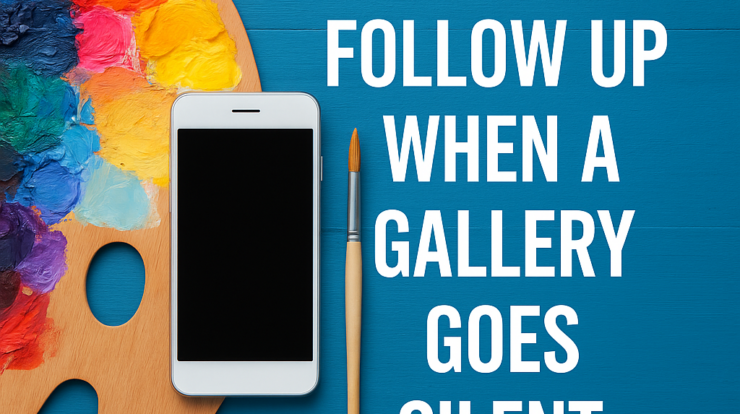
Every artist who’s pursued gallery representation has likely faced this frustrating scenario: a gallery responds positively to your portfolio, maybe even floats the idea of showing your work, and then… silence.
No rejection. No further conversation. Just an unfinished sentence hanging in your inbox.
The temptation is to overanalyze what went wrong—or worse, to do nothing at all and let the opportunity slip away. But here’s the reality: gallery owners are human. We’re juggling artist submissions, client relationships, events, marketing, inventory, and in many cases, just trying to stay ahead of the day. A promising lead can get buried under a stack of competing priorities. Your job as an artist isn’t to interpret the silence—your job is to professionally and persistently keep the conversation moving forward.
Let’s talk about how to do that without sounding desperate, pushy, or insecure.
Assume the Best—and Follow Up Anyway
If a gallery has expressed genuine interest—especially if they’ve asked questions or suggested a timeframe for showing your work—that’s not a casual compliment. It’s the beginning of a conversation. And like any business conversation, if one party falls silent, it’s perfectly reasonable for the other to follow up.
Send a short, polite email. A few sentences is all it takes:
“Just checking in on our previous conversation—I’m still very interested in showing with you and wanted to be sure this didn’t fall through the cracks.”
Include a small image of your work as a visual reminder. This isn’t just practical; it’s considerate. Gallery owners may be scanning dozens of emails a day—seeing your art again can trigger the memory and bring you back to the top of the list.
Then Pick Up the Phone
If you don’t hear back from the email, don’t let the trail go cold. Call. If no one answers, try again the next day. On the second or third attempt, leave a brief message:
“Hi, just wanted to follow up on our recent conversation about possibly showing my work in your gallery. I’d love to connect when you have a moment.”
Keep it warm, not needy. You’re not pestering—you’re demonstrating professionalism and follow-through.
Why This Matters
Too often, artists internalize silence as rejection. The fear of being perceived as “pushy” leads to missed opportunities. But in my experience, persistence is often what separates artists who land representation from those who don’t. It’s not a matter of talent—it’s a matter of staying on the radar.
I’ve had artists who followed up months after an initial contact and ended up in the gallery because they stayed present in my mind. I’ve also had conversations with other gallery owners who’ve said, “I meant to reach out, but they never got back to me.” In both cases, follow-up could have made the difference.
Don’t Let Doubt Get in the Way
One of the biggest obstacles to effective follow-up is the internal voice that whispers:
“Maybe they changed their mind.”
“Maybe they realized my work isn’t that good.”
“Maybe I’m being annoying.”
These thoughts are common, but they’re not useful. Silence from a gallery doesn’t mean rejection—it usually means distraction. Assume the best, act like a professional, and keep moving forward.
When to Let Go
If multiple follow-ups go unanswered over the course of a few weeks, you can step back—but don’t write the gallery off forever. Circle back in a few months. Sometimes timing is everything. The gallery may have hit a busy season, delayed an exhibition plan, or faced staffing changes.
Persistence isn’t about pressing harder—it’s about staying present without making the other party feel pressured. Think of it as a long game.
Final Thought
Gallery relationships begin the same way most professional relationships do: with a conversation that builds over time. Your ability to stay in the conversation—to follow up, to check in, to show respect for your own time and effort—is just as important as the quality of your art.
So the next time you hear silence, don’t disappear. Send the email. Make the call. Follow up.
You may be closer to “yes” than you think.